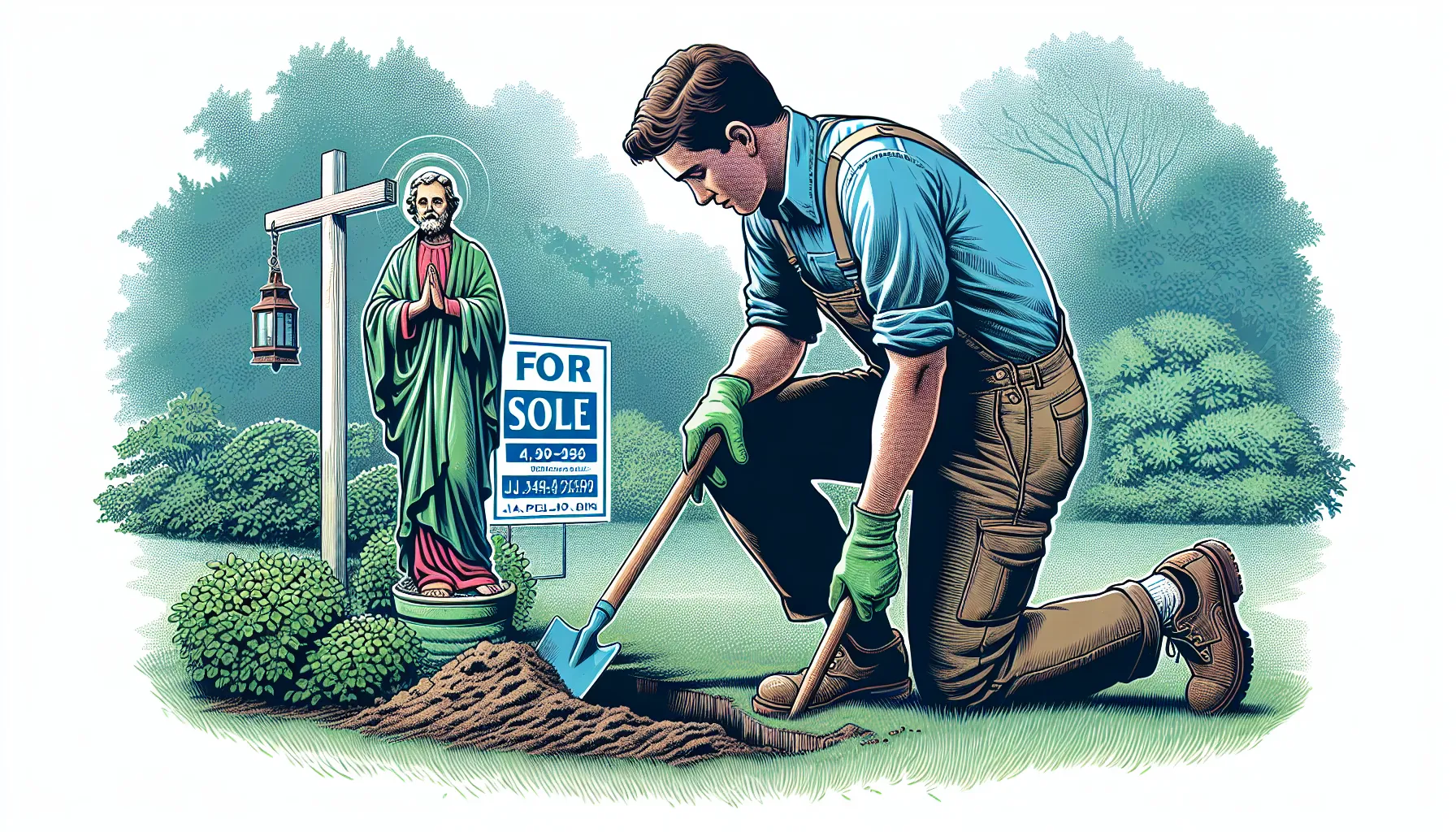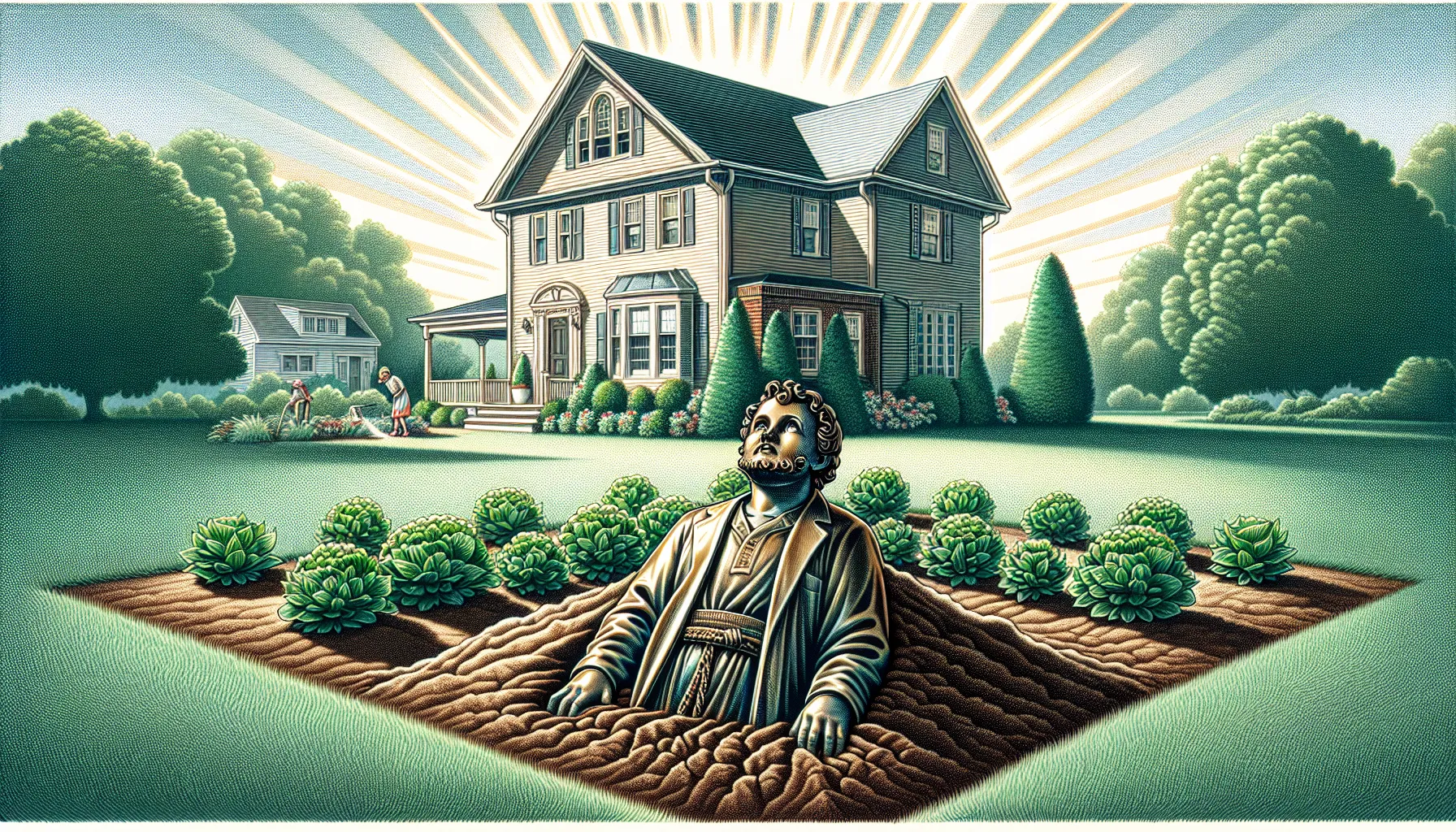Key Takeaways
- St. Joseph Statue Tradition: Burying a St. Joseph statue is a time-honored ritual believed to enhance the chances of selling a home quickly and favorably, with roots in European folklore and Catholic practices.
- Psychological Boost: The act of burying the statue can provide emotional comfort and a sense of control for homeowners facing the stress of selling, serving as a form of symbolic hope during uncertain times.
- Successful Anecdotes: Many homeowners report positive experiences and quick sales after engaging in the tradition, highlighting its role as a source of empowerment, though outcomes may vary.
- Market Factors Matter: While the ritual may offer hope, practical factors such as market conditions, timing, staging, and curb appeal are crucial for successfully selling a home.
- Skepticism and Balance: Critics argue that perceived successes may be coincidental and emphasize the importance of balancing traditional beliefs with sound real estate strategies to avoid misplaced reliance.
Selling a house can feel overwhelming, but many believe a simple ritual could tip the scales in their favor. Enter the St. Joseph statue—a quirky tradition where homeowners bury a statue of the saint in their yard, hoping to expedite the sale of their property. But does it really work?
We’ve all heard the stories of quick sales and miraculous offers, but what’s the truth behind this practice? On this journey, we’ll explore the origins of this belief, the experiences of those who’ve tried it, and whether there’s any real magic involved. As we dig deeper, we’ll also address common concerns like getting a fair offer and avoiding scams, giving you the insights you need to make informed decisions in your home-selling adventure.
Understanding the Tradition
The tradition of burying a St. Joseph statue during the home-selling process has roots in folklore and religious practices. This ritual is believed to enhance the odds of selling a house quickly and at a favorable price.
Origins of the St. Joseph Statue
The origins of the St. Joseph statue practice trace back to Europe, where St. Joseph is venerated as the patron saint of carpenters and by extension, home and family. Historically, homeowners buried his image upside down in their yards to compel a swift sale, which stems from the idea that asking for favor from a saint requires a demonstration of faith and urgency. This custom gained popularity in the United States during the 1970s, particularly among the Catholic community, and has since spread to various demographics. Statues of St. Joseph are now commonly available in stores and online, often accompanied by instructions and prayer suggestions designed to support home-selling endeavors.
Cultural Beliefs Surrounding Home Sales
Cultural beliefs around the St. Joseph rite encompass not only the practice itself but also the community support it fosters. Many sellers turn to this tradition during stressful selling periods, seeking comfort and hope. This process can be more than just a ritual; it serves as a psychological boost for homeowners facing the uncertain housing market. Rituals like burying the statue often reflect a broader human tendency to engage in symbolic acts that align with our desires and fears during significant life transitions. Although there’s no scientific evidence supporting the efficacy of this tradition, its popularity signals a collective search for control and confidence in what can often feel like an unpredictable process.
Embedding ourselves in these cultural practices enriches our understanding of the emotional aspects that accompany residential sales.
The Process of Burying the Statue

Burying a St. Joseph statue involves specific steps for those who believe in its potential to aid in selling a home. This tradition combines ritualistic actions with personal intentions, reflecting the seller’s hopes for a swift and successful sale.
Choosing the Right Statue
Selecting the appropriate St. Joseph statue is crucial for this practice. We recommend choosing a statue that resonates with us personally, as the belief in its power often stems from faith and intention. Statues typically range in size from 12 to 36 inches and can be found in garden stores or online retailers. It’s essential to consider the statue’s quality, as some homeowners prefer a traditional resin version while others opt for ceramic or metal. Many also find value in selecting a statue designed specifically for this purpose, which may come with guidance or blessings to enhance the ritual’s effectiveness.
Step-by-Step Guide to Burying the Statue
Burying the St. Joseph statue involves a straightforward process that we can follow easily. First, we decide on a location in the yard, ideally near a “For Sale” sign, facing the house. Next, we dig a hole deep enough to fully cover the statue—about one foot deep often works well. Before placing the statue in the ground, we might recite a prayer or positive affirmation regarding the sale. After burying the statue, we fill the hole back in, keeping our intentions clear in mind. Some recommend marking the spot with a small stone or garden ornament, while others prefer to leave the area undisturbed. This simple yet meaningful act reflects not just a belief in the statue’s efficacy but also a proactive approach to the home-selling process.
Anecdotal Evidence and Testimonials
Homeowners often share experiences regarding the tradition of burying a St. Joseph statue, reflecting a mix of hope and skepticism in their stories. Many believe that participating in this ritual can positively influence the sale process, highlighting how personal narratives shape our understanding of real estate practices.
Success Stories from Homeowners
Numerous homeowners report successful sales shortly after burying a St. Joseph statue, attributing their quick results to this ritual. For example, an Ohio couple buried a statue upside down in their front yard after struggling to sell their house for several months. Within weeks, they received multiple offers, ultimately closing the sale above their asking price. Another homeowner in Florida shared that after burying the statue, their listing received heightened interest, leading to a swift sale. These accounts reflect a broader trend where individuals feel empowered by engaging in this symbolic act, merging hope with proactive steps in their home-selling journey.
Skepticism and Criticism
While many celebrate the success stories, skepticism surrounds the ritual’s effectiveness. Critics argue that the favorable outcomes are mere coincidences, with market forces playing a significant role in sales rather than spiritual interventions. Several real estate experts express concerns that relying on folklore may distract sellers from essential tasks, such as pricing appropriately and marketing effectively. Some homeowners who participated in the tradition report no change in their selling experience, prompting them to question whether it serves as a mere placebo for anxiety in an unpredictable market. These varied perspectives underscore the importance of balancing tradition with practical strategies in real estate endeavors.
Factors Influencing Home Sales

Understanding the multifaceted factors influencing home sales allows us to navigate the real estate landscape more effectively. Several elements play a crucial role in determining how quickly and profitably a property sells.
Market Conditions and Timing
Market conditions significantly affect home sales. Economic indicators like interest rates, employment rates, and local market trends can either enhance or hinder buyer demand. For instance, when mortgage rates are low, buyers are more likely to enter the market, thereby increasing competition. Conversely, in a downturn, reduced buyer confidence often leads to longer sales timelines.
Timing also proves essential; listing during peak seasons—typically spring and summer—can attract more buyers. Sellers should closely monitor market trends to identify the most advantageous times for listing their properties. Utilizing resources like local real estate statistics can provide insights into when the majority of homes are sold, helping us align our strategies accordingly.
Staging and Curb Appeal
Staging a home and enhancing curb appeal create powerful first impressions that can expedite sales. Staged homes often sell faster and at higher prices, as they highlight a property’s potential. Effective staging involves decluttering, depersonalizing, and strategically arranging furniture to optimize space and flow.
Curb appeal, on the other hand, includes the exterior aspects that greet potential buyers. Simple improvements, such as fresh landscaping, clean walkways, and a well-maintained facade, can significantly enhance initial perceptions. A well-kept exterior signals to buyers that the home has been cared for, further inviting them to explore inside. Combining staging with a focus on curb appeal allows us to create an inviting experience, ultimately contributing to quicker sales.
Conclusion
Burying a St. Joseph statue can be a meaningful ritual for many of us looking to sell our homes. While it may not guarantee a quick sale, the tradition offers psychological comfort and a sense of control during an often stressful process. The blend of faith and proactive measures can create a positive mindset as we navigate the housing market.
Ultimately, we should remember that successful home sales rely on various factors like market conditions, pricing, and effective marketing strategies. Combining our personal beliefs with practical approaches can enhance our chances of achieving a favorable outcome. Whether we choose to embrace this tradition or focus on more conventional methods, the journey of selling our home can be both fulfilling and rewarding.
Frequently Asked Questions
What is the purpose of burying a St. Joseph statue?
Burying a St. Joseph statue is a tradition believed to help expedite the sale of a house. It’s rooted in folklore and religious practices, particularly among Catholics, where St. Joseph is considered the patron saint of homes and carpenters.
How does one properly bury a St. Joseph statue?
To bury a St. Joseph statue, choose a location in your yard, dig a hole, and place the statue upside down. Recite a prayer or affirmation, and cover it with soil. Marking the spot is optional, but many find it helpful for personal intentions.
Is there any scientific evidence supporting this practice?
No, there is no scientific evidence that supports the effectiveness of burying a St. Joseph statue in selling a home. The tradition is largely based on folklore, personal beliefs, and anecdotal experiences rather than empirical data.
What materials are St. Joseph statues made from?
St. Joseph statues come in various materials, including plastic, resin, ceramic, and metal. Choosing a statue that resonates personally with you is recommended, as this can enhance the personal significance of the tradition.
Can burying a St. Joseph statue guarantee a quick home sale?
No, while some homeowners report quick sales after following the ritual, results can be coincidental. Market conditions and effective selling strategies, such as pricing and staging, play a more crucial role in achieving a successful home sale.
What are some key factors affecting home sales?
Key factors include market conditions, timing, and economic indicators like interest rates. Listing during peak seasons, such as spring and summer, can attract more buyers, while effective staging and curb appeal significantly enhance a property’s attractiveness.
What are the benefits of staging a home for sale?
Staging a home highlights its potential, making it more appealing to buyers. Staged homes typically sell faster and often command higher prices, as staging creates a welcoming atmosphere that encourages buyers to envision themselves living there.
How can homeowners enhance curb appeal?
Homeowners can enhance curb appeal by improving landscaping, maintaining the exterior, and ensuring the front door area is clean and inviting. Simple upgrades, like fresh paint or decorative accents, can create positive first impressions that entice buyers.






